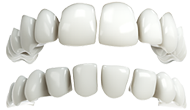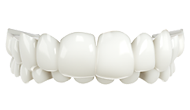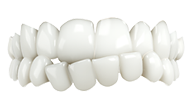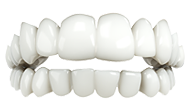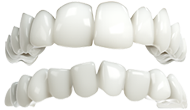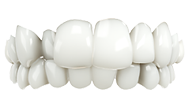Invisalign® Oakland & Pinole, CA
Teeth straightening with clear, nearly invisible braces.
Invisalign® straightens your teeth using a custom-made series of aligners created for you and only you. These aligner trays are made of smooth, comfortable and virtually invisible plastic that you wear over your teeth. They gradually and gently shift your teeth into place. There are no metal brackets to attach and no wires to tighten. You just pop in a new set of aligners approximately every two weeks, until your treatment is complete.
You’ll achieve a great smile with little interference to your daily life.
Invisalign® Treatment Process
You may be somewhat familiar with how the Invisalign treatment works, but we’d like to take you through each step of the treatment process, from consultation to confident smile. Whether you’re considering treatment for yourself or someone else, knowing more about the entire process can help you be more confident in your decision to choose Invisalign and enjoy a better smile every day.
Schedule an Invisalign® consultation with Smart Start Dental.
During your Invisalign consultation, you and your doctor will discuss your case in detail to determine if you’re a good candidate for Invisalign. Invisalign now addresses many cases, from simple to more complex. During your consultation at Smart Start Dental, your doctor will determine if Invisalign is right for you.
We create a customized treatment plan.
We will take digital X-rays, pictures and impressions of your teeth, which Invisalign will use to create a digital 3-D image of them. From these images, your doctor will map out a precise treatment plan, including the exact movements of your teeth, and tell you the approximate length of treatment. Using the same technology your doctor will be able to show you a virtual representation of how your teeth will move with each stage of treatment. While every case is unique to each patient, treatment typically takes approximately a year for adults. For teens, the length of treatments is comparable to that of traditional (metal) braces.
Receive your custom aligners based on your treatment plan.
Based on your individual treatment plan, a series of custom-made, clear aligners is then created specifically for you. These aligners are made of a smooth, comfortable, BPA-free plastic that won’t irritate your cheeks and gums like traditional metal braces often do. Simply wear them throughout the day, and remove them when you eat or to brush and floss your teeth. As you wear each set of aligners, your teeth gently and gradually begin to shift into place. And because they’re virtually invisible, most people won’t even notice you’re wearing them.
Wear a new aligner every two weeks.
Approximately every two weeks, you will begin wearing a new set of aligners, advancing you to the next stage of your treatment. To monitor your progress, you will also have occasional checkups at Smart Start Dental, usually only every six weeks or so. For best results and a timely outcome, you should wear your aligners for 20 to 22 hours per day, throughout your entire treatment. At every stage, you will be able to see how much closer you are to having the smile that reflects the real you.
Reveal your new smile and keep it looking great.
Congratulations! This is the time when you celebrate. You have reached the end of treatment and you will be smiling more than ever.
Once your treatment is complete, protect the beautiful new smile you have invested in. Ask your doctor if you will need retainers to keep your teeth in their new position and lock in your beautiful smile.
Invisalign® Treatable Cases
From mild cases of crooked teeth and protruding teeth, to much more difficult dental problems involving serious malocclusion, overbite, or underbite, Invisalign effectively corrects a wide variety of dental problems. Whether your teeth are widely gapped, overly crowded or somewhere in between, Invisalign has an affordable teeth straightening option for you.
Gapped teeth
Gaps between teeth can occur with abnormal continued growth of the jawbone. Missing teeth can also cause the surrounding teeth to shift due to the extra space, creating gaps in your teeth. Spacing issues and gaps between teeth can lead to gum problems (due to lack of protection by the teeth), periodontal pockets and increased risk of periodontal disease.
Overbite
Overbite occurs when the upper teeth bite over the lower teeth. It’s typically caused by genetics, bad oral habits, or over-development of the bone that supports the teeth. This can lead to gum problems or irritation, and/or wear on the lower teeth, and can cause painful jaw and joint problems.
Underbite
Underbite can occur when the lower teeth protrude past the front teeth. It’s usually caused by undergrowth of the upper jaw, overgrowth of the lower jaw, or both. Missing upper teeth can also cause the condition. This can prevent the normal function of front teeth or molars, which can lead to tooth wear. It can also cause painful jaw and joint problems.
Open bite
Open bite often occurs when some teeth are unable to make physical contact with the opposing teeth for a proper bite. Most often caused by a genetic abnormal jaw structure or excessive thumb-sucking, an open bite can cause poor or painful chewing, and even speech impairment. It can also lead to greater issues like temporomandibular joint disorder (TMJ).
Overly crowded
Teeth crowding occurs when there is simply a lack of room within your jaw for all of your teeth to fit normally. When left untreated, overly crowded teeth can get worse over time, and result in severely crooked teeth. This crowding can lead to plaque accumulation, tooth decay and an increased chance of gum disease.
Crossbite
Crossbite can occur when the upper and lower jaws are both misaligned. It causes one or more upper teeth to bite on the inside of the lower teeth, and can happen on both the front and the sides of the mouth. This can cause wear of the teeth, gum disease and bone loss.


